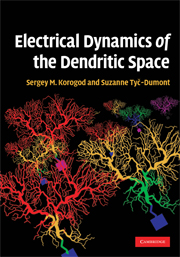Book contents
- Frontmatter
- Contents
- Preface
- 1 Definition of the neuron
- 2 3D geometry of dendritic arborizations
- 3 Basics in bioelectricity
- 4 Cable theory and dendrites
- 5 Voltage transfer over dendrites
- 6 Current transfer over dendrites
- 7 Electrical structure of an artificial dendritic path
- 8 Electrical structure of a bifurcation
- 9 Geography of the dendritic space
- 10 Electrical structures of biological dendrites
- 11 Electrical structure of the whole arborization
- 12 Electrical structures in 3D dendritic space
- 13 Dendritic space as a coder of the temporal output patterns
- 14 Concluding remarks
- Index
- References
4 - Cable theory and dendrites
Published online by Cambridge University Press: 03 May 2010
- Frontmatter
- Contents
- Preface
- 1 Definition of the neuron
- 2 3D geometry of dendritic arborizations
- 3 Basics in bioelectricity
- 4 Cable theory and dendrites
- 5 Voltage transfer over dendrites
- 6 Current transfer over dendrites
- 7 Electrical structure of an artificial dendritic path
- 8 Electrical structure of a bifurcation
- 9 Geography of the dendritic space
- 10 Electrical structures of biological dendrites
- 11 Electrical structure of the whole arborization
- 12 Electrical structures in 3D dendritic space
- 13 Dendritic space as a coder of the temporal output patterns
- 14 Concluding remarks
- Index
- References
Summary
A relevant mathematical tool to describe the bioelectricity in the neuronal dendrites is cable theory, which is based on application of the so-called cable equation to the core conductor model (Kernleitermodel) of the dendritic structure conducting currents and voltages. Exhaustive description of the cable theory and its application to analysis of electrical phenomena in the dendrites is provided in several excellent works (Taylor, 1963; Jack et al., 1975; Rall, 1977; Rall and Agmon-Snir, 1999; Koch, 1999). In this chapter, the basics of this theory are given with accentuation of the issues important for understanding the material in the following chapters.
Cable theory requires space in which electrical parameters are distributed. The dendritic space is shaped by the membrane into a tube-like branching structure. The tube diameter ranges from several micrometres (or even a fraction of a micrometre) to several tens of micrometers in diameter and the tube length can read hundreds or even thousands of micrometres. These dimensions of the dendritic space are much greater than the thickness of the membrane across which the charges are spatially separated to create the electric field. What happens in the space along and over the membrane tubes? This depends on spatial properties of the electrical field in this larger domain. If the charge separation and the electric field produced by molecular machines is different at different locations in the cable, then electrical voltage occurs and the corresponding current flows between these locations. The routes in the space along which the current flows are shaped by the dendritic structure. We focus on the electrical events in the dendritic cables.
- Type
- Chapter
- Information
- Electrical Dynamics of the Dendritic Space , pp. 47 - 58Publisher: Cambridge University PressPrint publication year: 2009



